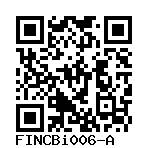mt1108 clone #121, mt1108 #121
FINCBi006-A
General
Cell Line |
|
| hPSCreg name | FINCBi006-A |
| Cite as: | FINCBi006-A (RRID:CVCL_D6I5) |
| Alternative name(s) |
mt1108 clone #121, mt1108 #121
|
| Cell line type | Human induced pluripotent stem cell (hiPSC) |
| Similar lines |
FINCBi005-A (mt1072 clone #103, mt1072 #103) Donor's gene variants: MT-ND6, MT-ND6, MT-ND4L, MT-ND4L Donor diseases: Leber hereditary optic neuropathy FINCBi001-A (F56Lcl33, F56L 33M) Donor's gene variants: MT-ND1, MT-ND1 Donor diseases: Leber hereditary optic neuropathy |
| Last update | 27th February 2024 |
| User feedback | |
Provider |
|
| Generator | Fondazione IRCCS Istituto Neurologico C. Besta (FINCB) |
| Owner | Fondazione IRCCS Istituto Neurologico C. Besta (FINCB) |
External Databases |
|
| BioSamples | SAMEA115082791 |
| Cellosaurus | CVCL_D6I5 |
| Wikidata | Q127380857 |
General Information |
|
| Publications | |
| * Is the cell line readily obtainable for third parties? |
Yes Research use: allowed
Clinical use: not allowed
Commercial use: not allowed
Additional restrictions:
cell line can be obtained by third parties using appropriate MTA |
Donor Information
General Donor Information |
|
| Sex | male |
| Ethnicity | caucasian |
Phenotype and Disease related information (Donor) |
|
| Diseases | A disease was diagnosed.
|
| Disease associated phenotypes | no phenotypes |
Karyotyping (Donor) |
|
| Has the donor karyotype been analysed? |
Unknown
|
Other Genotyping (Donor) |
|
| Is there genome-wide genotyping or functional data available? |
No
|
External Databases (Donor) |
|
| BioSamples | SAMEA115082792 |
Ethics
| Has informed consent been obtained from the donor of the embryo/tissue from which the pluripotent stem cells have been derived? | Yes |
| Was the consent voluntarily given? | Yes |
| Has the donor been informed that participation will not directly influence their personal treatment? | Yes |
| Can you provide us with a copy of the Donor Information Sheet provided to the donor? | No |
| Do you (Depositor/Provider) hold the original Donor Consent Form? | Yes |
| Please indicate whether the data associated with the donated material has been pseudonymised or anonymised. | pseudonymised |
| Does consent explicitly allow the derivation of pluripotent stem cells? | No |
| Does consent prevent CELLS DERIVED FROM THE DONATED BIOSAMPLE from being made available to researchers anywhere in the world? | No |
| How may genetic information associated with the cell line be accessed? | No information |
| Will the donor expect to receive financial benefit, beyond reasonable expenses, in return for donating the biosample? | No |
| Has a favourable opinion been obtained from a research ethics committee, or other ethics review panel, in relation to the Research Protocol including the consent provisions? | Yes |
| Name of accrediting authority involved? | Ethics Committee, Fondazione IRCCS Istituto Neurologico Carlo Besta, Milan, Italy |
| Approval number | n.60, 6th March 2019 |
| For generation of the cell line, who was the supplier of any recombined DNA vectors or commercial kits used? |
hIPSC Derivation
General |
|
| Source cell type |
Synonyms
|
Reprogramming method |
|
| Vector type | Non-integrating |
| Vector | Sendai virus |
| Is reprogramming vector detectable? |
No |
| Methods used |
PCR
|
Vector free reprogramming |
|
Other |
|
| Derived under xeno-free conditions |
Unknown |
| Derived under GMP? |
Unknown |
| Available as clinical grade? |
Unknown |
Culture Conditions
| Surface coating | Matrigel/Geltrex |
| Feeder cells |
No |
| Passage method |
Enzyme-free cell dissociation
EDTA
|
| O2 Concentration | 20 % |
| CO2 Concentration | 5 % |
| Medium |
Essential 8™ Flex
|
| Has Rock inhibitor (Y27632) been used at passage previously with this cell line? | Yes |
| Has Rock inhibitor (Y27632) been used at cryo previously with this cell line? | No |
| Has Rock inhibitor (Y27632) been used at thaw previously with this cell line? | Yes |
Characterisation
Analysis of Undifferentiated Cells
| Marker | Expressed | Immunostaining | RT-PCR | Flow Cytometry | Enzymatic Assay | Expression Profiles |
| POU5F1 (OCT-4) |
Yes |
|
|
|||
| TRA 1-60 |
Yes |
|
||||
| NANOG |
Yes |
|
|
|||
| SOX2 |
Yes |
|
|
|||
| ZFP42 (REX-1) |
Yes |
|
||||
| Alkaline Phosphatase |
Yes |
Differentiation Potency
In vitro spontaneous differentiation
In vitro spontaneous differentiation
In vitro directed differentiation
Genotyping
Karyotyping (Cell Line) |
|
| Has the cell line karyotype been analysed? |
Yes
normal male karyotype (46,XY)
Passage number: p7
Karyotyping method:
Array CGH
|
Other Genotyping (Cell Line) |
|


Login to share your feedback, experiences or results with the research community.